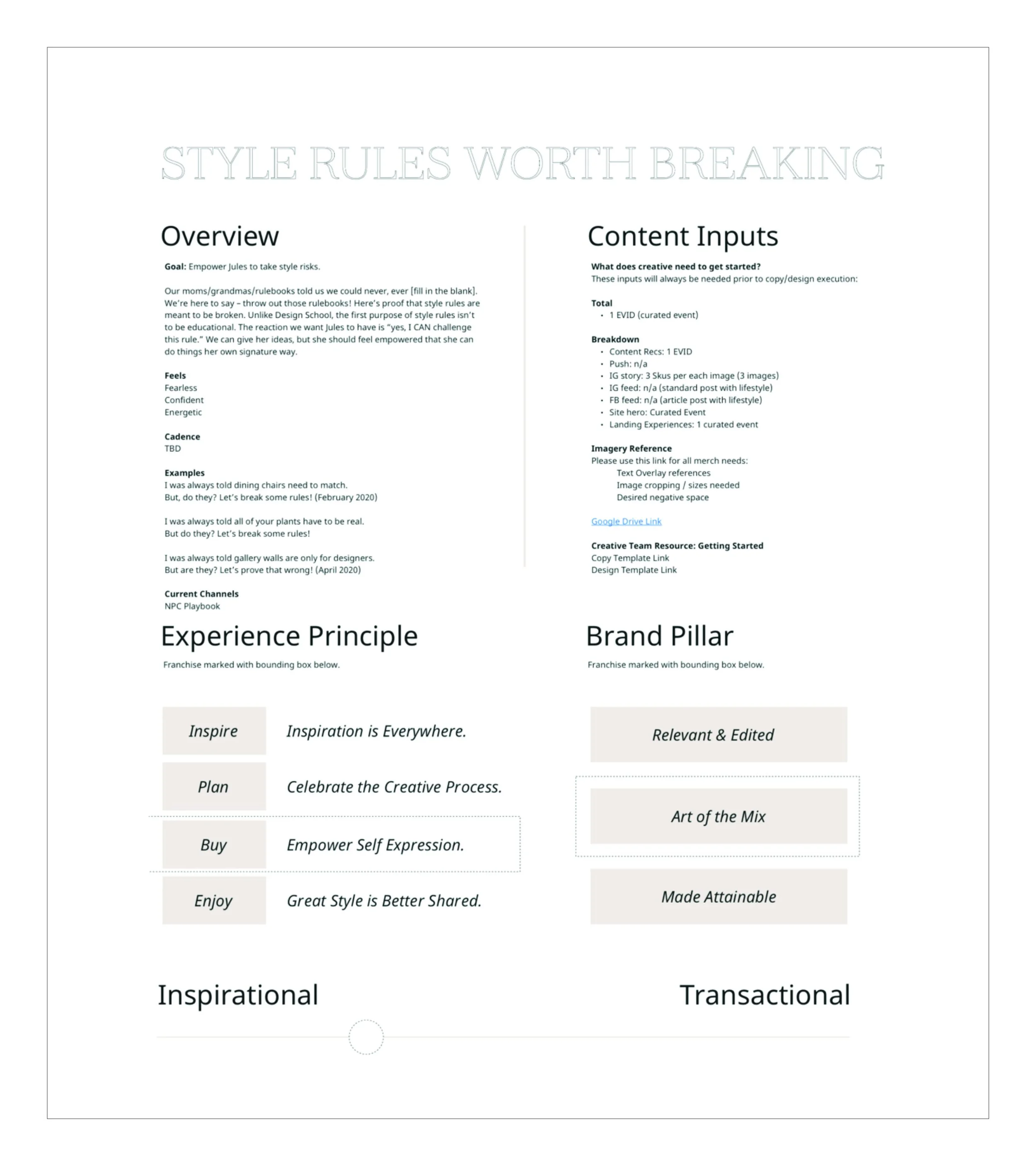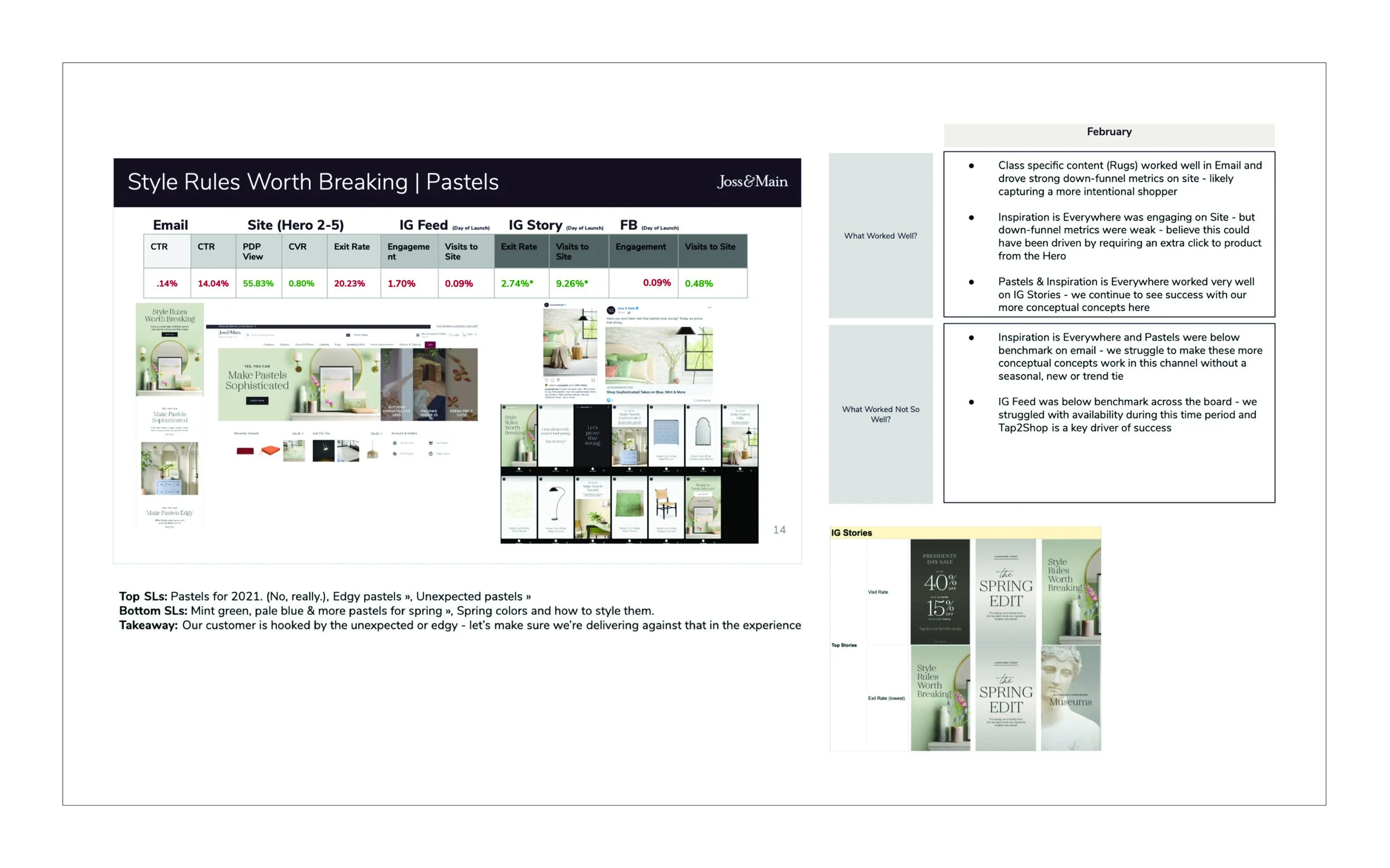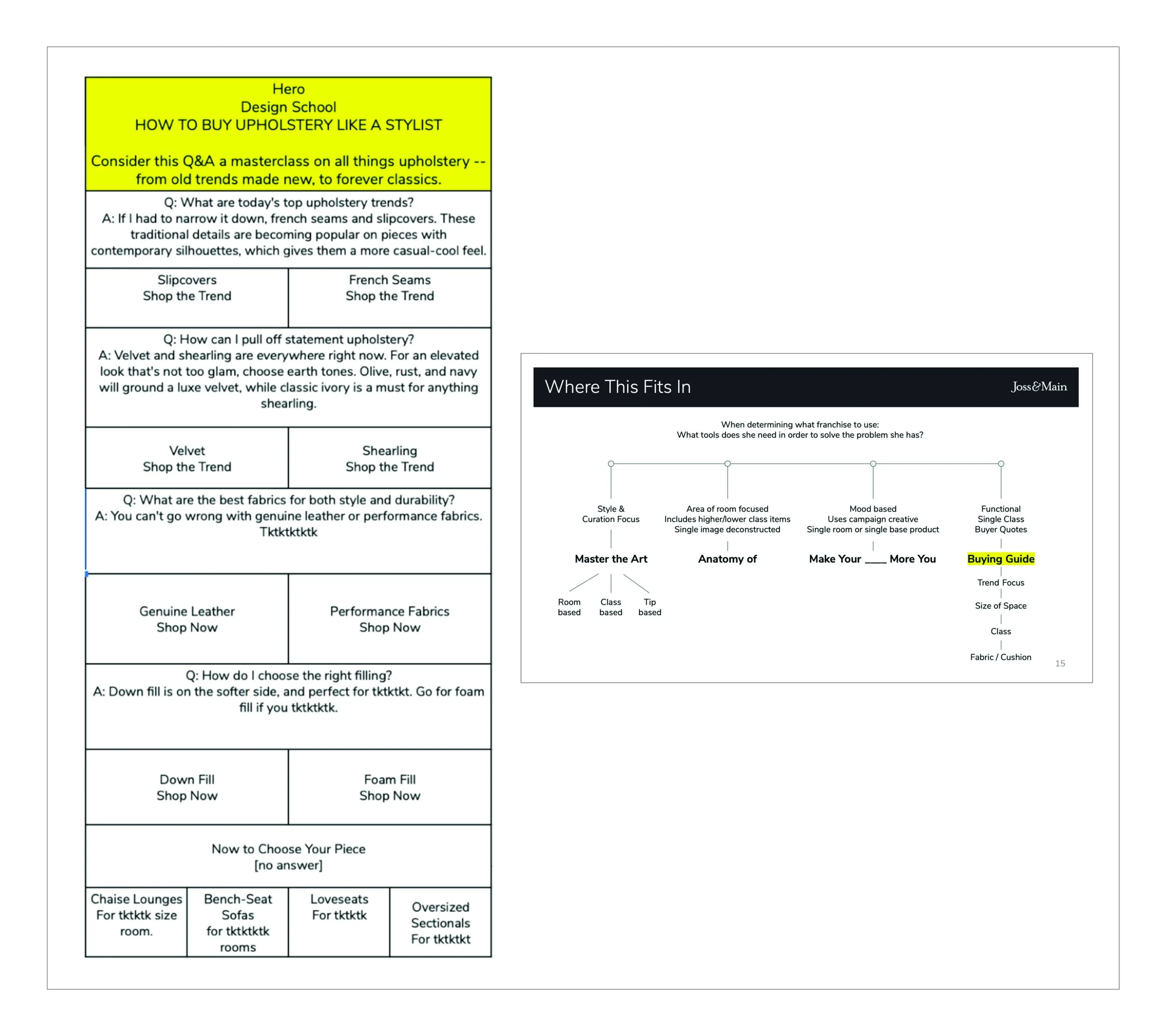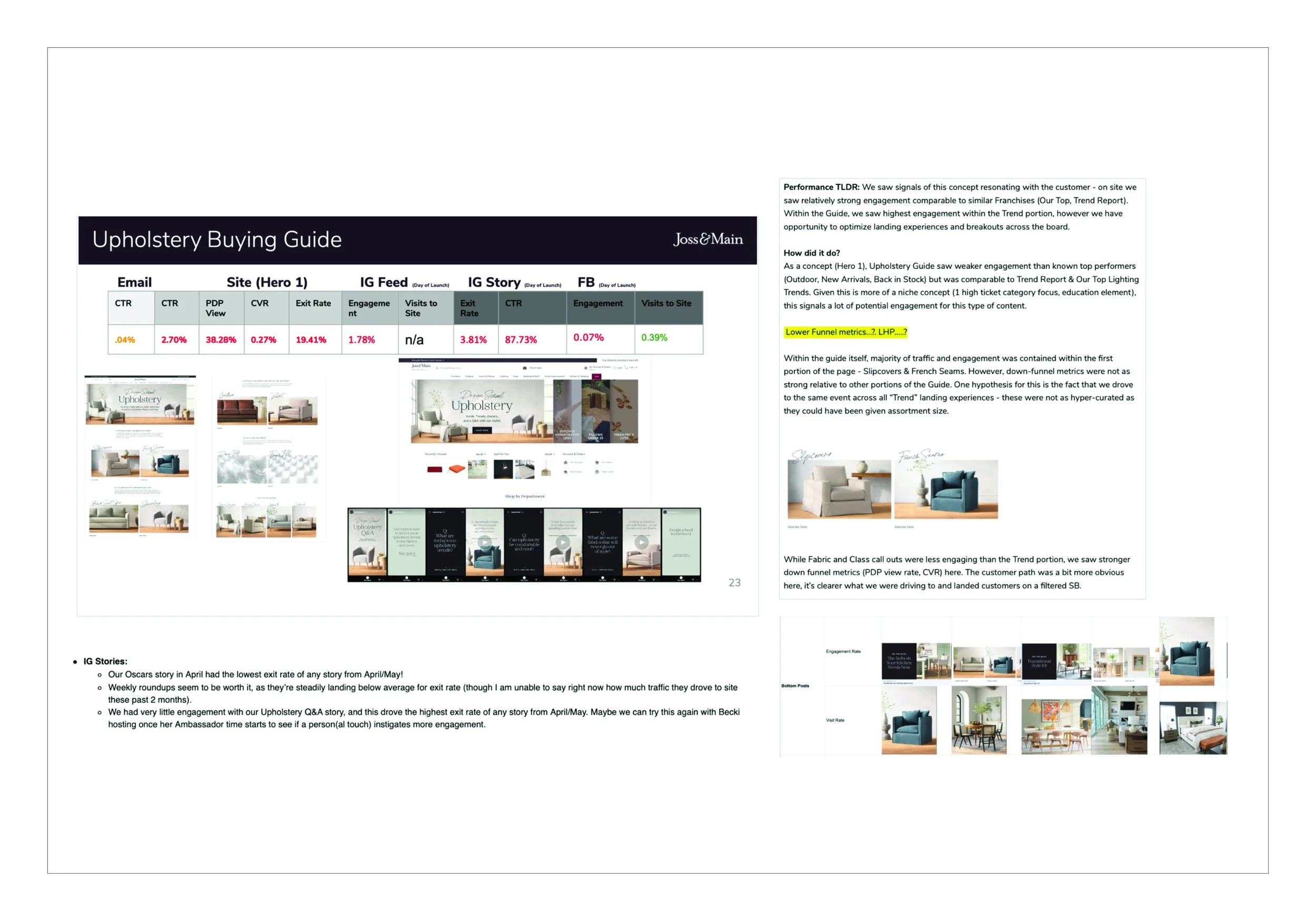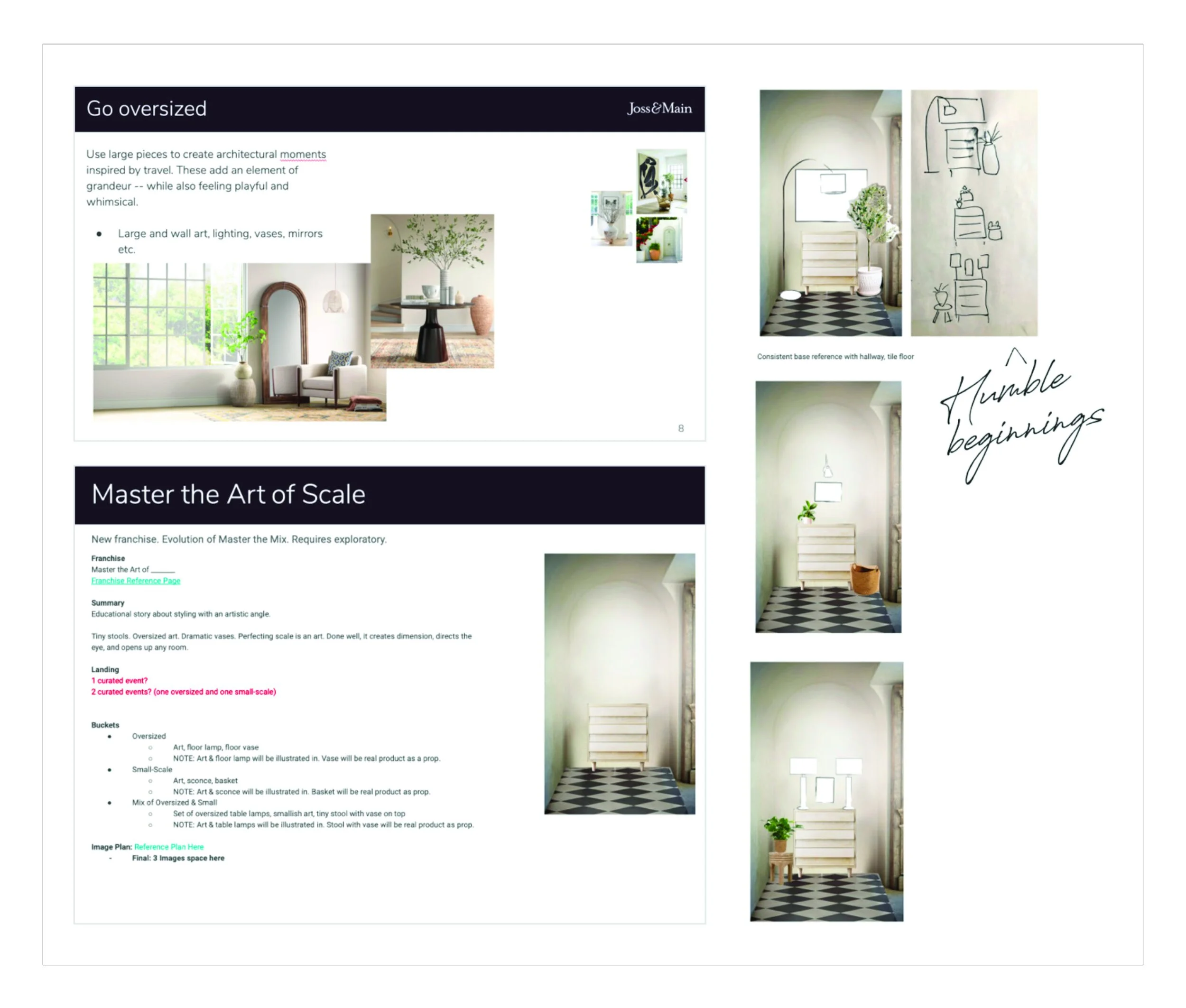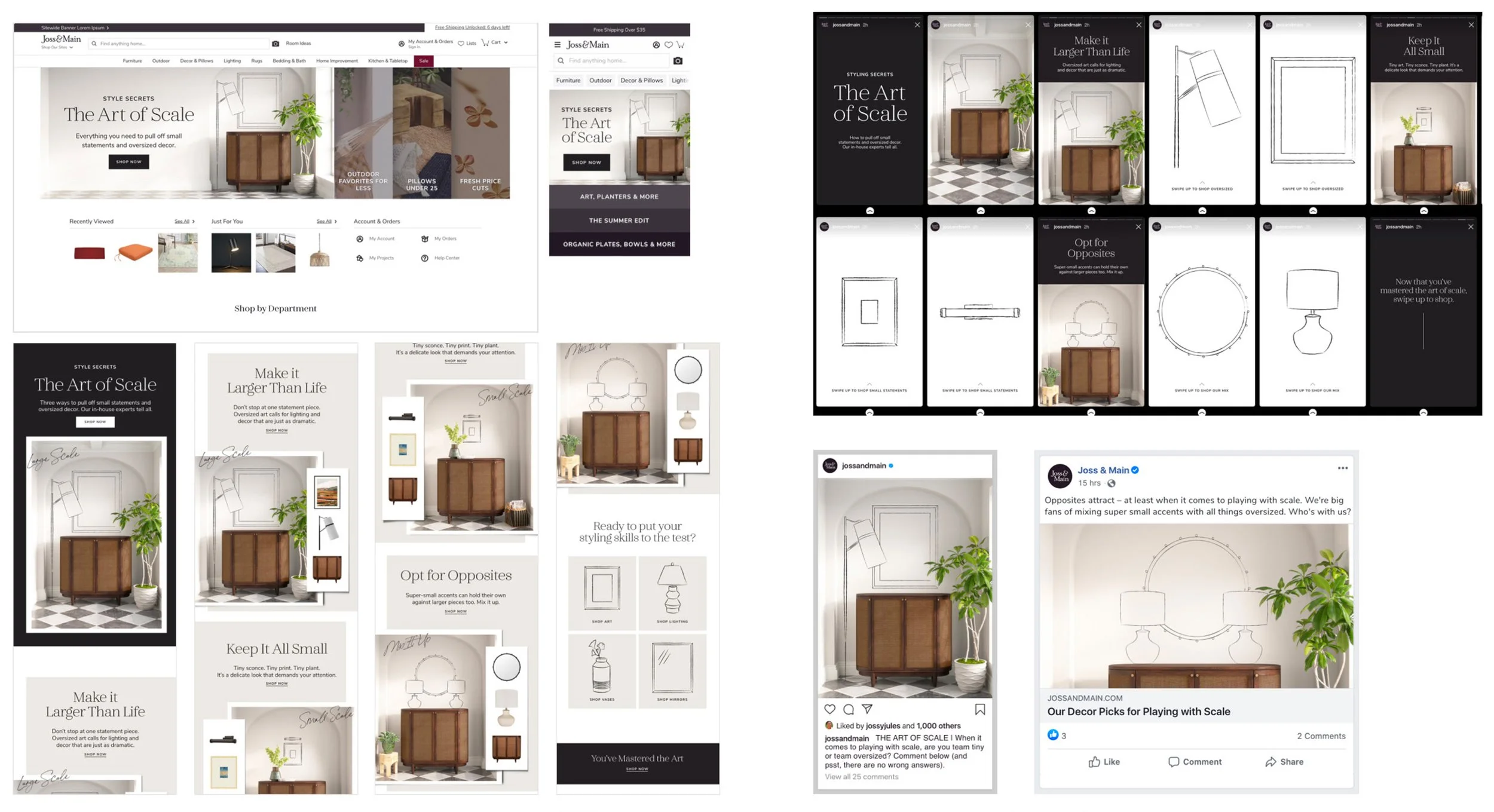How do I approach the creative process?
Have you ever noticed how design and cooking are so similar? For me, I’m passionate about both. If I had to describe my creative process, I’d say it’s like crafting a great new recipe. A little bit of inspiration here, a dash of strategy there, and the perfect mix of creativity to bring it all together. Intrigued? Great! Below, I’ll walk you through how this approach came to life in my work for Joss & Main (Wayfair), with real examples.
I’m Erinn, and I’ll be your host for today’s creative journey. Let’s get started!
WHAT MAKES A GREAT RECIPE?
Key ingredients & creative team goals
-
In design, just like in cooking, the first question is about harmony. What is the main goal of this project? Who is the audience? Does this design align with the brand’s purpose and message? Before diving into execution, I make sure all the elements—whether it's colors, typography, images, or copy—work together seamlessly to create a cohesive and effective design that serves both the brand’s needs and the user experience.
-
Just like following a recipe, design requires a clear, organized plan. Who are the key players involved, and how will their roles contribute to the process? What are the specific steps that need to be followed to ensure we stay on track? I make sure to break the project down into manageable phases—from concept to execution—while considering how we can measure success at each stage. Do we have data or insights from past projects that can inform this one? I use past performance and user feedback to guide the process and ensure that each step contributes to the final goal.
-
In both cooking and design, it’s easy to get lost in the details. But it’s essential to keep your eyes on the final goal. What’s the desired outcome? Each project will come with its own set of challenges and excitement, but the key is always staying aligned with the bigger picture. Is this design helping us move closer to where we want the brand to be? I continually check in on the brand’s purpose and vision, ensuring every decision I make brings us one step closer to the desired result.
-
Design is all about experimentation and refinement. Data is our friend, but it doesn’t dictate everything. While we rely on insights and past performance to guide us, we also embrace the process of trial and error. Testing different ideas and approaches allows us to discover what truly resonates with the audience. If we know certain combinations work, we can iterate on them to build even more success in future projects. It's all about learning, adapting, and refining to get the perfect result.
-
The best creatives (and cooks) pour love and care into every detail, knowing that the process is just as important as the final result. True passion comes from immersing yourself fully in the journey—from the first idea to the finished design. What drives creative people is the satisfaction of seeing their work connect with others. Whether it's a perfectly executed dish or a design that resonates with an audience, knowing that your efforts have made a meaningful impact is what keeps the creative process alive.
RECIPE 1: TRIED & TRUE
SIGNATURE DISH
Style Rules Worth Breaking
SIGNATURE DISH | GOALS & INSTRUCTIONS
Main Goal: Empower Our Customer
This is a snapshot of how my copy partner and I define SRWB (Style Rules Worth Breaking), the key information we gather from stakeholders to get started, and how it aligns with our brand’s experience principles and pillars.
SRWB: The pastel color palette was intentionally chosen as part of breaking the traditional design rule that pastels are only for certain seasons or spaces. By incorporating this unexpected choice, we aimed to elevate key product categories like mirrors, furniture, and lighting, while aligning with seasonal direction. This strategic move not only challenged the norm but also empowered customers to explore new design possibilities within these core categories.
SIGNATURE DISH | THE WHY
SRWB supported the seasonal direction in multiple ways across both imagery and content. When planning the content calendar, my copy partner and I ensure that over the course of several months, we strategically highlight key topics that support a variety of product categories. We aim to strike a balance between our core brand pillars and experience principles, featuring a mix of inspirational and transactional content. In this instance, we leaned more towards inspirational content, while still maintaining a shoppable feel by calling out specific product categories within the layouts.
SEASONAL DIRECTION & IMAGERY connection
Seasonal Direction & Color Input
Start by defining the seasonal direction and key color trends that will guide the visual and creative tone for the upcoming period.Present to Stakeholders with Swipe
Create and present a curated selection of inspiration images (swipes) to stakeholders, ensuring alignment with the overarching seasonal theme and brand vision.Get Buy-In
Secure approval and buy-in from key stakeholders, ensuring that the creative direction resonates with both the brand's vision and the seasonal strategy.Collaborate with Imagery Team, Buyers, and Merchandisers
Work closely with the imagery team, buyers, and merchandisers to ensure the visual elements align with product offerings, seasonal trends, and merchandising strategy. This collaboration helps bring the concept to life and ensures consistency across all touchpoints.
CROSS CHANNEL SUITE CREATED
SIGNATURE DISH | TRIAL, ERROR & TESTING
Congrats! We've served up our "dish" to the world—now, let's see how it’s received. This step is all about using data and feedback to evaluate the impact of our design. How did it perform? Do we need to tweak the flavors or adjust the presentation? Just like refining a recipe, we analyze the results and iterate based on insights, fine-tuning where necessary to ensure the next iteration is even more successful.
CREATIVE EVOLUTION
The following is a sampling of how creative has evolved, driven by data showing what resonates most with the customer. What began as a single carousel card on the homepage has grown into a full landing experience, designed to fully immerse the customer in the concept. This shift reflects the power of data-driven insights, allowing us to scale the creative and take over the site, offering a more engaging and cohesive experience that aligns with user preferences and behaviors.
RECIPE 2: THE WILD CARD
EXPERIMENTAL DISH
Design School: Upholstery
EXPERIMENTAL DISH | GOALS & INSTRUCTIONS
Main Goal: Design a buying guide that empowers our customers to choose the right upholstery for their home.
Fueling the Design with Buyer Insights:
We grounded the guide in key buyer insights, such as room sizes to consider, trending fabrics and materials, performance and durability factors, and specific product categories. This data ensured the guide addressed customer needs in a relevant, informative way.
Collaboration with Copy:
Teaming up with my copy partner, we aimed to differentiate this guide from typical product-focused content by honing in on functionality and quality rather than just styling. We kept the focus on a single product category, stripping away unnecessary design clutter, to deliver a clear, straightforward resource that directly supports customers in making confident purchasing decisions.
EXPERIMENTAL DISH | THE WHY
Our goal was to educate customers about different materials in a way that felt fresh and engaging. To do this, we created an experience that blends trends, materials, and stylist insights. The sample shown here is a wireframe first pass, built using a new system designed to streamline our approach.
We made sure this experience fit seamlessly into our content calendar, focusing on key product categories and higher-price-point items to align with our business goals.
The additional sample included here reflects our brainstorming process, ensuring this concept stood out from similar content. This exercise also helped stakeholders grasp the unique value of the buying guide, demonstrating why it was essential compared to other types of content we typically serve.
SEASONAL DIRECTION & IMAGERY connection
CROSS CHANNEL SUITE CREATED
EXPERIMENTAL DISH | TRIAL, ERROR & TESTING
Due to the limited SKU assortment available after customers landed on the page, we identified this as a key factor contributing to lower engagement. The next step was to collaborate directly with buyers and stakeholders to find a solution together. I believe this collaborative approach is the most effective, as it allows us to combine our expertise and align our efforts to create a better experience for the customer. At the end of the day, we all share the same goal: delivering a seamless, engaging experience that drives results.
How can we fix the fire in the kitchen?
Long-Term Optimization:
To create a more cohesive and engaging experience, we’ll focus on integrating fabric mixing and matching across key categories, from sofas to accent chairs. This will help customers visualize how to curate a complete, harmonious room. We’ll also emphasize sizing options, including oversized ottomans, poufs, and chairs, to provide more variety and flexibility. Additionally, collaborating with buyers to introduce light wood finishes, prioritize in-stock and ready-to-ship products, and highlight popular choices like swivel chairs will align our offerings with customer demand and seasonal trends.
Short-Term Optimization:
In the short term, we’ll update our class mix by removing underperforming sections, like the “fill” category, and replacing them with high-demand items like ottomans. We'll refresh the trend copy to better reflect our brand’s current direction, focusing on curves and wood frames—two areas that resonate strongly with our audience. Lastly, we’ll introduce new categories, such as upholstered benches and headboards, to round out our offering and increase variety.
RECIPE 3: JUST ADDED
NEW ON THE MENU
The Art of Scale
NEW ON THE MENU | GOALS & INSTRUCTIONS
Main Goal: Create an educational story about styling with an artistic angle.
This project showcases the evolution of content planning, where we tied in high-level seasonal trends across multiple categories to craft a cohesive, educational narrative. The content culminates in a full-site takeover experience, designed to engage and inspire customers.
I personally illustrated all of the artwork featured throughout this experience, adding a unique, creative touch to the storytelling.
COMMENT CARD
LISTEN TO YOUR CUSTOMER
I believe the key to great creativity lies in being flexible and open to feedback. Listening to the customer’s voice, using data to refine our goals, and trusting our instincts allow us to craft the best "recipes" for success. It’s a balance of understanding customer needs, analyzing trends, and pushing creative boundaries to deliver experiences that truly resonate.
